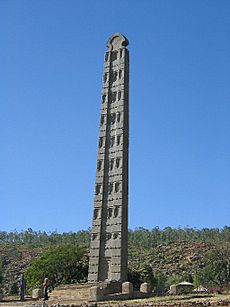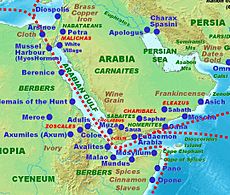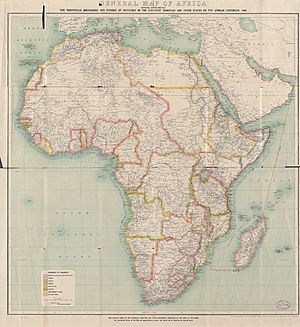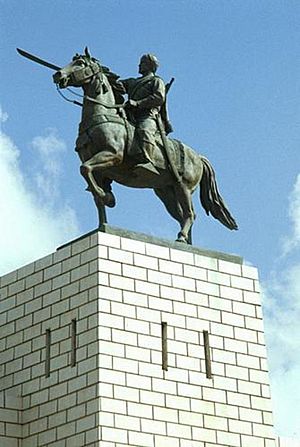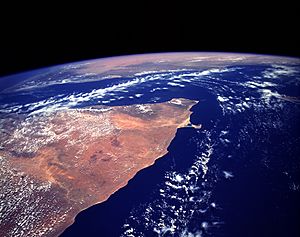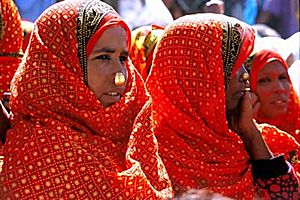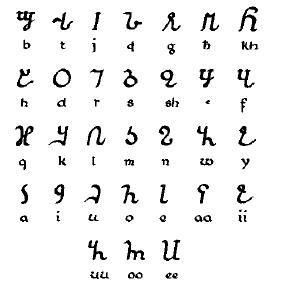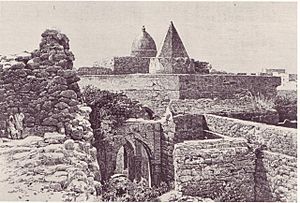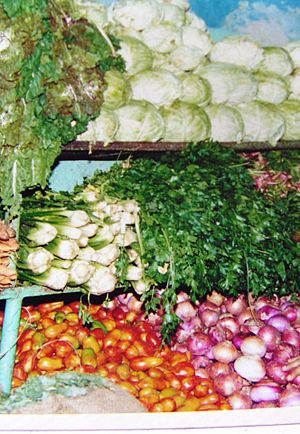Horn of Africa facts for kids
Quick facts for kids Horn of Africa |
|
|---|---|
 |
|
| Countries |
1 unrecognised state
|
| Population | 140,683,144 (2020 est.) |
| Area | 1,882,757 km2 |
The Horn of Africa (HoA), also called the Somali Peninsula, is a large land area in East Africa. It is the easternmost part of the African continent. This makes it the fourth largest peninsula in the world. The region includes Somaliland, Somalia, Djibouti, Ethiopia, and Eritrea. Sometimes, parts of Kenya and Sudan are also included. The Horn of Africa is very important because it sits near the southern end of the Red Sea. It also reaches into the Gulf of Aden, the Guardafui Channel, and the Indian Ocean. It shares a sea border with the Arabian Peninsula.
Contents
- Exploring the History of the Horn of Africa
- Geography and Climate of the Horn of Africa
- Wildlife and Plants of the Horn of Africa
- People and Languages of the Horn of Africa
- Culture and Achievements of the Horn of Africa
- Religions in the Horn of Africa
- Economy of the Horn of Africa
- Images for kids
- See also
Exploring the History of the Horn of Africa
Ancient Times: Early Humans and Kingdoms
Scientists have found old shell piles in Eritrea that are 125,000 years old. These show that early humans ate seafood they found on beaches. Evidence from genes and fossils suggests that modern humans first developed in Africa. This happened between 200,000 and 100,000 years ago. They might have spread out from the Horn of Africa.
Today, the Bab-el-Mandeb straits in the Red Sea are about 20 kilometers wide. But 50,000 years ago, the sea was much narrower. Sea levels were also 70 meters lower. The straits were never fully closed. There might have been islands that people could reach using simple rafts. It is thought that only a small group of people, perhaps 150 to 1,000, crossed the Red Sea. They came from a larger group of 2,000 to 5,000 people in Africa.
Experts believe that the first people who spoke Afro-Asiatic languages came to this region. This happened during the Neolithic era (New Stone Age). They might have come from the Nile Valley or the Near East. Other experts think these languages started in the Horn itself. Then, the speakers spread out from there. Genetic studies also show that people from the Near East settled in Northeast Africa. These early groups later became the Afro-Asiatic speaking people in the Horn and Maghreb.
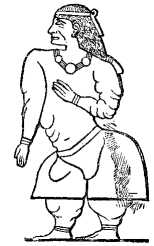
The land known as Punt was likely in northern Somalia, Djibouti, and the Red Sea coast of Sudan and Eritrea. Ancient Egyptians first wrote about Punt around 2500 BCE. They called it "Ta Netjeru," meaning "god's land."
The kingdom of Dʿmt existed in Eritrea and northern Ethiopia from the 8th to 7th centuries BCE. Its capital was Yeha. This kingdom developed ways to water crops and used plows. They grew millet and made iron tools. After Dʿmt fell around 500 BCE, smaller kingdoms took over. Then, the Kingdom of Aksum rose in the 1st century CE and brought the area back together.
The Kingdom of Aksum was an ancient state in the Eritrean highlands and Ethiopian Highlands. It was powerful between the 1st and 7th centuries CE. Aksum was important in trade between the Roman Empire and Ancient India. Its rulers even made their own coins to help with trade. Aksum also took control over the weakening Kingdom of Kush. It often got involved in the politics of kingdoms on the Arabian Peninsula. Eventually, Aksum conquered the Himyarite Kingdom. Under King Ezana (around 320–360 CE), Aksum became the first major empire to adopt Christianity. A prophet named Mani called Aksum one of the four great powers of his time. The others were Persia, Rome, and China.
Northern Somalia was a key link for trade in the Horn. It connected the region's trade with the rest of the ancient world. Somali sailors and merchants were the main suppliers of frankincense, myrrh, and spices. These were valuable luxury goods for the ancient Egyptians, Phoenicians, Mycenaeans, Babylonians, and Romans. Because of these valuable goods, the Romans called the region Regio Aromatica (Aromatic Region). In the classical era, many Somali city-states grew wealthy. Places like Opone, Mosylon, and Malao competed for the rich trade between India and the Greco-Roman world.
When Islam began on the Red Sea coast, merchants and sailors in the Horn were influenced by the new religion. Muslim families moved from the Islamic world to the Horn in early Islamic times. Later, Muslim scholars peacefully converted local people. The ancient city-states became Islamic cities like Mogadishu, Berbera, Zeila, Barawa, and Merka. These were part of the Berber civilization. Mogadishu became known as the "City of Islam." It controlled the East African gold trade for many centuries.
Middle Ages: Powerful Sultanates and Dynasties
During the Middle Ages, several strong empires controlled trade in the Horn. These included the Adal Sultanate, the Ajuran Sultanate, the Warsangali Sultanate, the Zagwe dynasty, and the Sultanate of the Geledi.
The Sultanate of Showa, founded in 896, was one of the oldest local Islamic states. It was located in central Ethiopia. The Sultanate of Ifat took its place around 1285. Ifat was ruled from its capital at Zeila in northern Somalia.
The Adal Sultanate was a medieval Muslim state in the Horn region. At its strongest, it controlled large parts of Somalia, Ethiopia, Djibouti, and Eritrea. Many historic cities in the region were part of it.
The Warsangali Sultanate was a kingdom in northeastern and parts of southeastern Somalia. It was one of the largest sultanates in the area. At its peak, it included the Sanaag region and parts of the northeastern Bari region. This area was known as Maakhir. The Sultanate was founded in the late 13th century by a group of Somalis.
The Ajuran Sultanate had a strong government and a powerful army. It successfully fought off attacks from the Oromo people from the west and the Portuguese from the east.
The Zagwe dynasty ruled many parts of modern Ethiopia and Eritrea from about 1137 to 1270. The dynasty's name comes from the Agaw people of northern Ethiopia. From 1270 onwards, the Solomonic dynasty ruled the Ethiopian Empire for many centuries.
In the early 15th century, Ethiopia tried to make contact with European kingdoms. This was the first time since the Aksumite era. A letter from King Henry IV of England to the Emperor of Abyssinia still exists. In 1428, Emperor Yeshaq sent two messengers to Alfonso V of Aragon.
The first ongoing relations with a European country began in 1508 with Portugal. This happened under Emperor Lebna Dengel. This was important because Portugal helped the Ethiopian emperor. They sent weapons and soldiers when the Adal Sultanate General Ahmad ibn Ibrahim al-Ghazi attacked Abyssinia. This help allowed Emperor Gelawdewos, Lebna Dengel's son, to defeat Ahmad. This war was also one of the first "proxy wars" in the region. The Ottoman Empire and Portugal supported different sides.
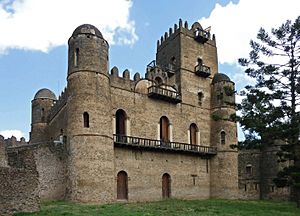
When Emperor Susenyos became a Roman Catholic in 1624, many years of fighting followed. Thousands of people died. Jesuit missionaries had upset the local Ethiopians' Orthodox faith. On June 25, 1632, Susenyos's son, Emperor Fasilides, made Ethiopian Orthodox Christianity the state religion again. He sent away the Jesuit missionaries and other Europeans.
In the late 18th and early 19th centuries, the Yejju dynasty ruled northern Ethiopia. They changed the official language of the Amhara people to Afaan Oromo. This included the court in Gondar, which was the capital.

The Sultanate of the Geledi was a Somali kingdom. It was ruled by the Gobroon dynasty in the 18th and 19th centuries. It was started by Ibrahim Adeer, who defeated other groups and set up the House of Gobroon. The dynasty became very powerful under Sultan Yusuf Mahamud Ibrahim. He made the Gobroon rule strong during the Bardera wars. Sultan Ahmed Yusuf later made powerful groups like the Omani Empire pay tribute.
The Majeerteen Sultanate was another important Somali sultanate in the Horn. King Osman Mahamuud ruled it during its best time. It controlled much of northeastern and central Somalia in the 19th and early 20th centuries. This sultanate had a modern government and a strong trading network. It also made agreements with foreign powers. Much of its old territory is now the Puntland region in northeastern Somalia.
The Sultanate of Hobyo was a 19th-century Somali kingdom. Sultan Yusuf Ali Kenadid founded it. Kenadid first wanted to take control of the Majeerteen Sultanate. But he failed and had to go to Yemen. Ten years later, in the 1870s, Kenadid returned from the Arabian Peninsula. He had a group of soldiers and loyal helpers. With their help, he created the kingdom of Hobyo. It ruled much of northeastern and central Somalia during that time.
Modern History: Independence and Change

After the Suez Canal opened in 1869, European powers wanted more land in Africa. Italy invaded and took over Eritrea. On January 1, 1890, Eritrea officially became an Italian colony. In 1896, Ethiopian forces stopped further Italian advances. However, by 1936, Eritrea became part of Italian East Africa. This area also included Ethiopia and Italian Somaliland. By 1941, Eritrea had about 760,000 people, including 70,000 Italians. British forces and Ethiopian fighters drove out the Italians in 1941. The British then managed the area under a UN Mandate until 1951. In 1951, Eritrea joined with Ethiopia, as decided by the UN.
Eritrea was important because of its Red Sea coast and minerals. This was the main reason it joined Ethiopia. In 1952, Ethiopia made Eritrea its 14th province. This was part of Ethiopia slowly taking more control. In 1959, Ethiopia made it mandatory to teach Amharic, Ethiopia's main language, in all Eritrean schools. Because Eritrea's people felt ignored, an independence movement started in the early 1960s. This led to a 30-year war against Ethiopian governments. The war ended in 1991. After a UN-watched vote in Eritrea, the people voted for independence. Eritrea declared its independence and was recognized by other countries in 1993. In 1998, a border dispute with Ethiopia led to the Eritrean–Ethiopian War.
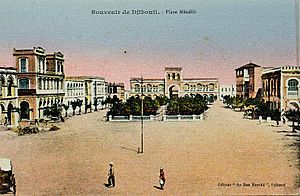
From 1862 to 1894, the land north of the Gulf of Tadjoura in modern-day Djibouti was called Obock. It was ruled by local Somali and Afar leaders. France signed treaties with them to get a foothold in the region. In 1894, Léonce Lagarde set up a permanent French government in Djibouti City. He named the region Côte française des Somalis (French Somaliland). This name was used until 1967.
In 1958, before neighboring Somalia became independent in 1960, a vote was held in Djibouti. People decided whether to join Somalia or stay with France. The vote was in favor of staying with France. This was partly because many Afar people and Europeans voted yes. There were also reports of unfair voting, with France sending away thousands of Somalis before the vote. Most Somalis who voted no wanted to join a united Somalia. Mahmoud Harbi, a leader who supported joining Somalia, was killed two years later. Djibouti finally became independent from France in 1977. Hassan Gouled Aptidon, a Somali politician, became the nation's first president. In early 2011, people in Djibouti protested against the government. This was part of the larger Arab Spring protests. The protests ended by April, and the ruling party was re-elected.
Mohammed Abdullah Hassan's Dervish State successfully fought off the British Empire four times. They forced the British to retreat to the coast. Because of these wins, the Dervish State was recognized as an ally by the Ottoman Empire and German Empire. The Turks even named Hassan the leader of the Somali nation. The Germans promised to recognize any lands the Dervishes took. After 25 years of keeping the British away, the Dervishes were finally defeated in 1920. This happened because Britain started using air attacks. After these attacks, the Dervish lands became a British protectorate. Italy also faced strong resistance from Somali leaders and armies. Italy did not fully control parts of modern Somalia until the Fascist era in late 1927. This control lasted until 1941. Then, a British military government took over. Northern Somalia remained a protectorate, while southern Somalia became a United Nations Trusteeship. The two regions joined in 1960 to form the Somali Republic. A civilian government was created. On July 20, 1961, a new constitution was approved by a public vote.
Because of its long history with the Arab world, Somalia joined the Arab League in 1974.
The early 20th century in Ethiopia was marked by the rule of Emperor Haile Selassie I. He came to power after Iyasu V was removed. In 1935, Haile Selassie's troops fought and lost the Second Italo-Ethiopian War. After this, Italy took over Ethiopia and added it to Italian East Africa. Haile Selassie then spoke to the League of Nations. His speech made him famous worldwide. He was named Time magazine's Man of the Year in 1935. After Italy entered World War II, British forces and Ethiopian fighters freed Ethiopia in 1941.
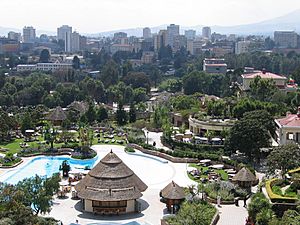
Haile Selassie's rule ended in 1974. A military group called the Derg, supported by the Soviet Union, took over. They were led by Mengistu Haile Mariam. They set up a one-party communist state called the People's Democratic Republic of Ethiopia. In July 1977, the Ogaden War started. The President of Somalia, Siad Barre, wanted to add the Somali-inhabited Ogaden region to a larger Somalia. By September 1977, the Somali army controlled 90% of Ogaden. But they had to leave after Ethiopia's Derg got help from the Soviet Union, Cuba, and other countries. This included about 15,000 Cuban soldiers.
In 1989, the Tigrayan Peoples' Liberation Front (TPLF) joined with other groups. They formed the Ethiopian Peoples' Revolutionary Democratic Front (EPRDF). They eventually overthrew Mengistu's government in 1991. A temporary government was then set up. The first free and fair election happened in 1995. Meles Zenawi became Ethiopia's longest-serving Prime Minister. Ethiopia kept its close ties with countries in the Middle East during this time. Zenawi died in 2012, but his EPRDF party is still the ruling group in Ethiopia.
Geography and Climate of the Horn of Africa
The Horn of Africa is about halfway between the equator and the Tropic of Cancer. It is mostly made of mountains that rose up when the Great Rift Valley formed. This valley is a crack in the Earth's crust. It stretches from Turkey to Mozambique. It shows where the African and Arabian tectonic plates are moving apart.
Geologically, the Horn and Yemen were once one large landmass. This was about 18 million years ago. Then, the Gulf of Aden formed, separating the Horn from the Arabian Peninsula. The Somali Plate is bordered by the East African Rift to the west. This rift goes south from the Afar Depression.
Large glaciers once covered the Simien Mountains and Bale Mountains. But they melted at the start of the Holocene epoch. The mountains drop steeply to the Red Sea. They slope more gently to the Indian Ocean. Socotra is a small island in the Indian Ocean off the coast of Somalia. It is part of Yemen.
The lowlands of the Horn are usually dry, even though they are near the equator. This is because the winds from the tropical monsoons blow from the west. These winds bring rain to the Sahel and the Sudan. But they lose their moisture before reaching Djibouti and Somalia. So, most of the Horn gets little rain during the monsoon season.

In the mountains of Ethiopia, many areas get over 2,000 mm of rain each year. Even Asmara gets an average of 570 mm. This rainfall is the only source of water for many areas outside Ethiopia, including Egypt. In winter, the winds from the northeast do not bring much moisture. Only mountainous areas of northern Somalia get rain in late autumn. This can add up to 500 mm per year. On the eastern coast, strong ocean currents and winds blowing parallel to the coast mean annual rainfall can be as low as 50 mm.
The climate in Ethiopia changes a lot between regions. It is generally hotter in the lowlands and milder on the plateau. In Addis Ababa, temperatures range from 4°C to 26°C. The weather is usually sunny and dry. There are short rains from February to April and big rains from mid-June to mid-September. The Danakil Desert covers 100,000 square kilometers in northeast Ethiopia, southern Eritrea, and northwestern Djibouti. This area is known for its volcanoes and extreme heat. Daily temperatures are often over 45°C. It has lakes formed by lava flows. These include Lake Asale and Lake Giuletti/Afrera. The Afrera area has many active volcanoes, like Maraho, Dabbahu, Afdera, and Erta Ale.
In Somalia, the climate does not change much with the seasons. It is hot all year, with regular monsoon winds and irregular rain. Average daily high temperatures are from 28°C to 43°C. Higher areas along the eastern coast are cooler because of a cold ocean current. Somalia has only two permanent rivers, the Jubba and the Shabele. Both start in the Ethiopian Highlands.
Wildlife and Plants of the Horn of Africa
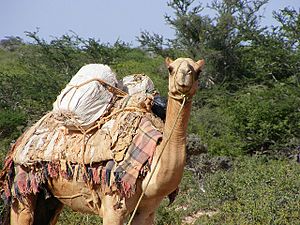
About 220 types of mammals live in the Horn of Africa. Some threatened species of antelope in the region include the beira, the dibatag, the silver dikdik, and the Speke's gazelle. Other interesting animals are the Somali wild ass, the desert warthog, the hamadryas baboon, the Somali pygmy gerbil, the ammodile, and the Speke's pectinator. The Grévy's zebra is the only wild horse-like animal here. Predators include spotted hyenas, striped hyenas, and African leopards. The endangered African wild dog used to live here. But human activities and wars have reduced their numbers.
Some important bird species in the Horn are the black boubou, the golden-winged grosbeak, the Warsangli linnet, and the Djibouti francolin.
The Horn of Africa has more unique reptiles than any other part of Africa. There are over 285 species, and about 90 of them are found only here. Half of these unique reptile groups are found only on Socotra island. Unlike reptiles, there are not many amphibians in the region.
There are about 100 types of freshwater fish in the Horn of Africa. About 10 of them are found only here. These include the cave-dwelling Somali blind barb and the Somali cavefish.
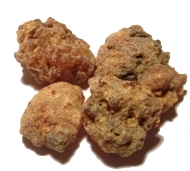
It is thought that about 5,000 types of vascular plants grow in the Horn. About half of these are found only here. Most unique plants are on Socotra and in northern Somalia. The region has two plant families found nowhere else: the Barbeyaceae and the Dirachmaceae. Other notable plants include the cucumber tree (found only on Socotra), the Bankoualé palm, the yeheb nut, and the Somali cyclamen.
Because the Horn of Africa has a dry climate, droughts are common. These are made worse by climate change and changes in farming. For centuries, the region's pastoral groups (people who raise livestock) had good ways to manage their land. They avoided overgrazing and saved land for young or sick animals. But population growth has put pressure on the limited land. This means these old practices are not always followed. Droughts in 1983–85, 1991–92, 1998–99, and 2011 have caused cattle numbers to drop by 37% to 62%.
People and Languages of the Horn of Africa
The countries of the Horn of Africa share similar land and are mostly linked by language and ethnic groups. There is a complex mix of relationships among the different communities.
According to Ethnologue, there are 10 different languages spoken in Djibouti, 14 in Eritrea, 90 in Ethiopia, and 15 in Somalia. Most people in the Horn speak Afro-Asiatic languages. These languages belong to the Cushitic or Semitic branches. Cushitic languages include Oromo, spoken by the Oromo people in Ethiopia, and Somali, spoken by the Somali people in Somalia, Djibouti, and Ethiopia. Semitic languages include Amharic, spoken by the Amhara people of Ethiopia, and Tigrinya, spoken by the Tigrinyas of Eritrea and Tigrayans of Ethiopia. Other Afroasiatic languages with many speakers include Afar, Saho, Hadiyya, Sidamo, and Agaw. Semitic languages also include Tigre, Arabic, Gurage, Harari, Silt'e, and Argobba.
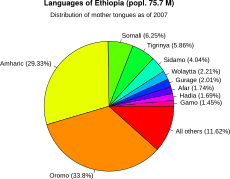
Additionally, Omotic languages are spoken by Omotic communities in southern Ethiopia. These languages include Aari, Dizi, Gamo, Kafa, Hamer, and Wolaytta.
Languages from the Nilo-Saharan and Niger-Congo families are also spoken. These are used by Nilotic and Bantu ethnic minorities in some areas. Nilo-Saharan languages include Me'en and Mursi in southwestern Ethiopia. Kunama and Nara are spoken in parts of southern Eritrea. In southern Somalia, Bajuni, Barawani, and Bantu groups speak forms of Swahili and Mushunguli.
Culture and Achievements of the Horn of Africa
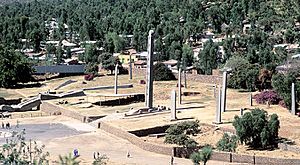
The countries of the Horn of Africa have been the birthplace of many old and new cultural achievements. These include advances in farming, buildings, art, food, education, literature, music, technology, and religion.
Ethiopian farming shows the earliest known use of the grain Teff (Poa abyssinica). This happened between 4000 and 1000 BCE. Teff is used to make the flat bread injera. Coffee also started in Ethiopia and is now a popular drink worldwide. Ethiopian art is famous for its old tradition of Ethiopian Orthodox Christian pictures. These go back to wall paintings from the 7th century CE. Somali architecture includes the Fakr ad-Din Mosque. It was built in 1269 by Fakr ad-Din, the first Sultan of the Sultanate of Mogadishu. Ethiopia is also known for its ancient churches, like those at the UNESCO World Heritage Site in Lalibela.
The Horn has created many writing systems. One is Ge'ez script (ግዕዝ Gəʿəz), also called Ethiopic. It has been used for at least 2000 years. It is a type of script where each symbol represents a consonant and a vowel. It was first used to write the Ge'ez language. In languages like Amharic and Tigrinya, it is called fidäl (ፊደል), meaning "script" or "alphabet."
In the early 20th century, people wanted a writing script for the Somali language. Osman Yusuf Kenadid, a Somali poet, created a detailed alphabet called Osmanya (also known as far soomaali). This script was designed to represent the sounds of Somali.
The music of the Ethiopian highlands uses a special musical system called qenet. There are four main modes: tezeta, bati, ambassel, and anchihoy. Three other modes are variations of these. Some songs are named after their qenet, like tezeta, which is a song about memories.
In technology, the Great Stele of Axum was over 30 meters tall. It was the largest single stone ever cut in the ancient world.
Religions in the Horn of Africa

Most people in the Horn of Africa follow one of the three main Abrahamic faiths. These religions have been present in the region for a very long time.
The ancient Aksumite Kingdom made coins and stone pillars with symbols of the god Ashtar. The kingdom later became one of the first states to adopt Christianity. This happened after King Ezana II converted in the 4th century.
Islam was brought to the northern Somali coast early on from the Arabian Peninsula. This was soon after the hijra (migration of Muslims). At Muhammad's request, a group of persecuted Muslims fled across the Red Sea to the Horn. There, the Muslims were given protection by the Aksumite King Aṣḥama ibn Abjar.
Also, Judaism has been present in the region for a long time.
Economy of the Horn of Africa
In 2010, the Horn of Africa region had a total economic output (GDP) of $106.224 billion. The average GDP per person was $1061.
More than 95 percent of trade between countries in the region is unofficial. It is not recorded. This trade is done by pastoralists (people who raise livestock) selling animals. The unofficial trade of cattle, camels, sheep, and goats from Ethiopia to other countries in the Horn, like Somalia and Djibouti, is worth about $250 to $300 million each year. This is 100 times more than the official numbers. The towns of Burao and Yirowe in Somaliland have the largest livestock markets in the Horn of Africa. As many as 10,000 sheep and goats are sold daily. Many of these animals are shipped to Gulf states from the port of Berbera. This trade helps lower food prices, makes food more available, eases border tensions, and helps the region work together. However, because this trade is not regulated, diseases can spread more easily across borders. Also, governments lose out on tax money and foreign currency.
Images for kids
See also
 In Spanish: Cuerno de África para niños
In Spanish: Cuerno de África para niños



